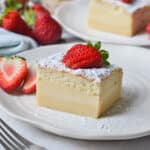Magic Custard Cake Recipe
This creamy vanilla custard cake is a simple, one-pan recipe that magically transforms into 3 layers while it bakes. The top is golden brown and fluffy, similar to genoise sponge cake. The middle layer is smooth, silky custard and the base is dense and rich, like vanilla fudge. A delicious and easy one-pan dessert, with minimal effort from you!
Servings: 9 slices
Calories: 226kcal
Ingredients
- 4 large eggs room temperature, separated into whites and yolks (130 grams egg whites and 55-60 grams egg yolks).
- ¾ cup caster sugar raw or white caster sugar
- 3 teaspoons vanilla bean paste
- ½ cup butter 125 grams, melted
- ¾ cup plain flour sifted
- 2 cups milk 500ml
- ½ teaspoon white vinegar
To serve
- icing sugar
- ground nutmeg optional
- fresh berries
Instructions
- Pre-heat the oven to 160 °C/320 F. Grease a 20cm x 20cm (8 x 8 inch) square baking tin with butter and line with baking paper. The baking paper should extend up the sides of the tin, for easy cake removal.
- Place the egg yolks into a large mixing bowl with the caster sugar. Beat with an electric beater for 5 minutes, until the mixture is thick and pale.
- Add the vanilla and melted butter and beat on low speed until combined.
- Add the sifted flour and gently mix until just combined.
- Heat the milk in the microwave or stovetop, until it is warm to touch, but not hot or boiling. Add the milk to the egg yolk mixture and whisk to combine (or continue to beat and add a little at a time). The mixture will be quite runny. This is normal.
- Add the egg whites to a separate mixing bowl and beat with the electric mixer (clean beaters) until stiff peaks form. Add the vinegar and continue to beat for an extra minute.
- Using a spatula, gently fold the egg whites into the thin cake batter, one third at a time. There will still be some small lumps of egg whites floating on the top of the batter. This is fine.
- Pour the cake batter into the prepared cake tin. Bake for around 40-50 minutes (start to check for doneness at 30 minutes) or until the sides of the cake are set, the top is golden brown and there is a very slight 'jiggle' when shaken. The cake should not wobble too much when tested, or it is not quite ready. Cooking times will vary depending on the oven and tin used.
- Remove the cake from the oven and allow to sit at room temperature for an hour before covering and transferring to the fridge. Allow the cake to sit in the fridge for 4 hours (or overnight) before slicing, to allow the layers to set.
- When ready to serve, slice the cake into pieces and serve with a dusting of icing sugar or ground nutmeg. You can also serve with fresh berries and/or whipped cream. Enjoy!
Video
Notes
- Use room temperature eggs. Leave them out of the fridge overnight, or place them in a bowl of warm water and wait for 5 minutes.
- Large eggs are used in this recipe. Due to eggs varying in size, I have included weights (in grams) for both the egg whites and yolks.
- The milk should be warm to touch (36-40 degrees Celsius/98-105 Farenheit). Be careful not to overheat. If the milk is too hot, set it aside to cool slightly.
- Use the right size cake tin. A tin that is too big will make the batter too shallow and will make it difficult for the layers to form.
- Don’t over-mix! This step is critical for the formation of the individual custard cake layers. Gently fold the egg whites into the batter, but don’t over-mix. A lumpy batter is ok, it will resolve when baking.
- The baking time can vary for this cake depending on the oven and type of tin used. I have tested this cake many times in different ovens and tins and the baking time is slightly different each time. Generally, 35-50 minutes is required, but start to test at 30 minutes. The cake is ready when it is golden on the top, will feel firm to touch, is set around the edges and has a slight wobble in the middle, but does not “jiggle” when gently shaken.
- Storage – store this cake in the fridge for 3-4 days.
- Rest! Magic custard cake needs time to rest. The cake needs time to come to room temperature and then rest in the fridge (at least 4 hours, or overnight) for the layers to finish setting properly.
- For lemon custard cake, add 1 tablespoon of lemon zest and ¼ cup lemon juice to the batter before baking.
- For a custard tart flavour, add a dusting of nutmeg over the top instead of icing sugar. It tastes so good!
- Please note that the nutrition information is based on the mixture being sliced into 9 pieces, with one slice being one serve. The nutritional information is an estimate only.
- This recipe is made using Australian cups and spoon measurements. Due to cup sizes varying from country to country, I advise adjusting if necessary.
- There are many variations of custard cake online. This recipe is based on this Magic Cake, made famous by Jo Cooks.
Nutrition
Calories: 226kcal | Carbohydrates: 28g | Protein: 6g | Fat: 10g | Saturated Fat: 5g | Polyunsaturated Fat: 1g | Monounsaturated Fat: 3g | Trans Fat: 1g | Cholesterol: 98mg | Sodium: 60mg | Potassium: 136mg | Fiber: 1g | Sugar: 21g | Vitamin A: 458IU | Calcium: 87mg | Iron: 1mg
